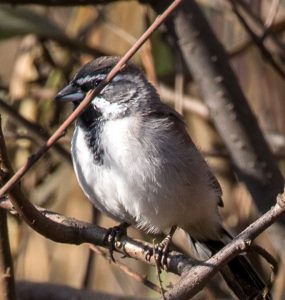
These days, Harold Reeve says he’s only running, “12 to 15 miles a week.” He runs more when he’s training for a marathon or shorter race, but no matter how often or how far he runs, he always carries a pair of binoculars.
The binoculars are Reeve’s way of combining passions; he loves running, but he also loves birding. Combining the two sports sounds implausible, but in addition to keen eyes, Reeve has a good ear and has learned to recognize a multitude of bird songs and call notes. Whenever he sees or hears something intriguing, he pauses in his run for a few moments of birding time.
Last Sunday, Reeve’s run took him a few miles from home and into Ceres’ River Bluff Park. As soon as he passed through the entrance gate, Reeve turned left and then headed north past the soccer fields toward the Tuolumne River. He ran until he came to a large pond near the river, then went closer to the river itself, to a brushy area full of low willows and Russian Thistle.
As he paused to look and listen, Reeve noted at least seven Lincoln’s Sparrows in the willows and nearby brush. Reeve’s expertise in local birds includes a fascination with numbers, so he waited a bit to see how many more Lincoln’s Sparrows he could tally. He then noticed there were also some Savannah Sparrows in the vicinity.
Just as he was keeping a mental record of the numbers of these common sparrows, Harold Reeve experienced one of those golden moments all birders seek—an unexpected sighting and new bird for his county list.
Sparrows as a rule are among the group all but hardcore birders call “LBBs,” short for Little Brown Birds. Although close looks can reveal beautiful subtleties and gradations of color, appreciation for most sparrows is an acquired taste, especially given their preference for deep brush and cover; most casual birders are content to identify them as LBBs and move on.
The sparrow that suddenly popped up in front of Harold Reeve wasn’t just unexpected, it was atypical. Rather than muted browns, its plumage was a bold mix of black on white with shades of gray. Instead of skulking in the deep brush, the bird was perched on an exposed branch. With the rising sun at his back, and the spectacular image of a new bird for Stanislaus County before him, Harold Reeve forgot about counting Lincoln’s Sparrows and began a sprint for home.
Reeve’s wife Sharon says he arrived home breathless and babbling of sparrows, his cell phone, and his camera. An accomplished birder herself, she knew the drill: Get the word out to local birders, gather equipment, and drive back to the site where the bird was last seen in hopes of getting a decent photo. And since she has her own impressive list of Stanislaus County birds, Sharon Reeve was also hoping to see the new bird.
Within a few short minutes, the Reeves had found a parking lot close to the willows and brush where Harold had seen the rare bird. Soon, Sharon Reeve also saw Stanislaus County’s first documented record of a Black-throated Sparrow, a bird whose usual range is in the American southwest.
Not long thereafter, Jim Gain, who had gotten word of the sighting via the Reeves’ email and phone messages, arrived with his Canon camera and managed to grab a good photograph of what had now become a very elusive bird that tended to stay on the move and deep in the brush.
Harold Reeve and other local birding enthusiasts couldn’t help but contemplate the vagaries of local birding. Stay at it for decades, and the degree of difficulty of adding to your list ratchets up with each new bird, at least theoretically.
But Reeve had found the Black-throated Sparrow only two weeks after adding another new bird to the county list on October 14, when he found a Northern Shrike in the southeastern part of the county. Prior to that sighting, however, it had been almost two years since anyone had managed to find a new species for the Stanislaus County list, which now numbers 321.
Local birders are now hoping Reeve’s recent success will translate to a cluster of new sightings, and they’re revising their predictions of which species will show up next. Number 322 could be somewhere in the county even now, and with Harold Reeve bucking the odds and on a run, the optimists are even hoping 323 will arrive sooner rather than later. Spirits are high and the hunt is on.
